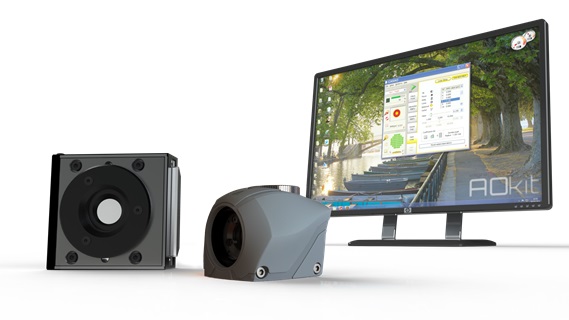SPIM or Light Sheet Microscopy Increase the fluorescence signal
Given its low phototoxicity, Selective Plane Illumination Microscopy (SPIM) or light sheet microscopy is currently the fastest imaging technique suitable for live imaging of voluminous biological samples. The samples and capillary, typically used as a sample holder, induce aberrations that limit the optical quality of the imaging system. Adaptive Optics has proven to be very effective at correcting this sort of aberration. It drastically improves the resolution and contrast of the image and allows reaching deeper layers of the biological sample.
Light sheet excitation is also becoming an increasingly popular technique in single molecule localization microscopy (SMLM), where it excites fluorescence in only a thin section of the sample instead of in the whole volume. For example, with a specially designed sample holder, the single objective SPIM (soSPIM)* technique uses the same objective lens to send the light-sheet excitation to the sample and to collect the emitted fluorescence signal. This results in an increased signal-to-noise ratio, allowing the user to reach deeper layers of the sample, where maintaining image quality would not be possible without Adaptive Optics aberration correction.
Figure caption: (A) Schematic representation of the soSPIM imaging system combined with the MicAO adaptive optics system from Imagine Optic for system and sample induced aberration correction, enabling in-depth 3D single molecule imaging. (B) Representation of the acquired volume 12 µm above the coverslip surface with an objective depth of focus of 1µm. (C) Raw single molecule DNA-PAINT data illustrating the 60 nm RMS astigmatism induced with the deformable mirror of the MicAO system in order to allow for 3D single molecule localization. (D) Depth-coded projection of the localization acquired within the volume shown in (B) of the protein Lamin-B1, demonstrating the 3-D shape of the nuclear envelope in non-adherent cells.
* soSPIM was jointly developed by CNRS, University of Bordeaux and the National University of Singapore by Rémi Galland, Gianluca Grenci, Vincent Studer, Virgile Viasnoff and Jean-Baptiste Sibarita. https://doi.org/10.1038/nmeth.3402
This collaborative work between Imagine Optic and the Quantitative Imaging of the Cell group at the Interdisciplinary Institute for Neuroscience was possible thanks to the following funding: Cifre, ANR, soSPIM.
Selected publications:
A. Hubert et al. “Adaptive optics light-sheet microscopy based on direct wavefront sensing without any guide star.” Optics Letters 2019, 44, 2514-2517.
K.M. Dean et al. “Imaging subcellular dynamics with fast and light-efficient volumetrically parallelized microscopy.” Optica 2017, 4, 263-271.
R. Jorand et al. “Deep and clear optical imaging of thick inhomogeneous samples.” PLoS ONE 2012, 7, e35795+.


